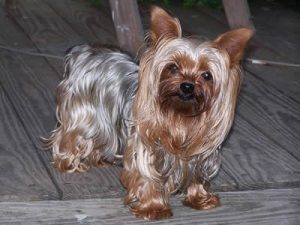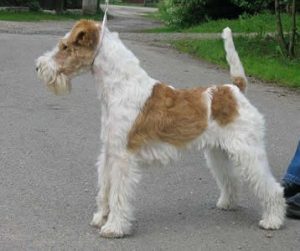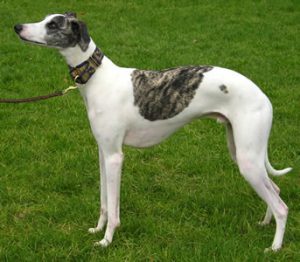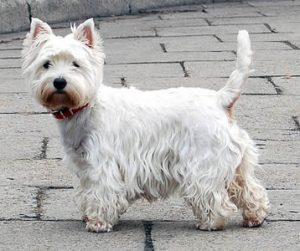
The Yorkshire Terrier is a small dog breed of Terrier type, developed in the 1800s in the historical area of Yorkshire in England. The defining features of the breed are its small size and its silky blue and tan coat. The breed is nicknamed Yorkie and is placed in the Toy Terrier section of the Terrier Group by the Fédération Cynologique Internationale and in the Toy Group or Companion Group by other kennel clubs, although all agree that the breed is a terrier. A winning showdog and a popular companion dog, the Yorkshire Terrier has also been part of the development of other breeds, such as the Australian Silky Terrier.
Coat care
If the coat is the correct silky texture, maintenance for it is relatively easy, requiring a daily brushing and a bath every month. Owners may trim the fur short for easier care. For shows, the coat is left long, and may be trimmed to floor length to give ease of movement and a neater appearance. Hair on the feet and the tips of ears can also be trimmed.
The traditional long coat is extremely high maintenance. To prevent breakage, the coat may be wrapped in rice paper, tissue paper, or plastic, after a light oiling with a coat oil. The oil has to be washed out once a month and the wraps must be fixed periodically during the week to prevent them from sliding down and breaking the hair. Elaborate care of the beautiful coat dates from the earliest days of the breed. In 1878, John Walsh described similar preparations: the coat is “well greased” with coconut oil, the dog is bathed weekly, and the dog’s feet are “carefully kept in stockings.”
Other colours
The Yorkshire Terrier is a tan dog with a blue saddle. Parti colours exist, although they are not correct for the breed standard. The parti colour coat Is white with black/blue and tan. It’s very rare to get a a parti colour yorkie, and if they are found they tend to be very expensive. The breed is defined by its colour, and colours promoted as “rare” may indicate health problems or cross-breeding with other breeds of other colours. The AKC registration form for Yorkshire Terriers allows for four choices: blue and tan, blue and gold, black and tan, black and gold. Colour alone will not affect whether or not a dog is a good companion and pet. Even though off-coloured Yorkshire Terriers are advertised at premium prices, being of an unusual or untypical colour is neither new, desirable, nor exotic.
Until recently, mismarked Yorkshire Terriers could be crossed with Biewer Terriers, a new breed originated in Germany from parti coloured Yorkshire Terriers. Although the American Kennel Club will not deny registration of a Yorkshire Terrier on colour alone, the Yorkshire Terrier Club of America has a directive that “any solid colour or combination of colours other than blue and tan” for adult dogs is a disqualification, and “dogs of solid colour, unusual combination of colours, and parti-colours should be disqualified.”
Character
The ideal Yorkshire Terrier character or “personality” is described with a “carriage very upright” and “conveying an important air”. Though small, the Yorkshire Terrier is intelligent and active, loves attention and should not show the soft temperament seen in lapdogs.
—————————————————————————————————————–
CARING FOR YOUR DOG NEWSLETTER – Delivered Directly To Your Inbox – Starting Immediately – SIGN UP FOR FREE TODAY
—————————————————————————————————————–




